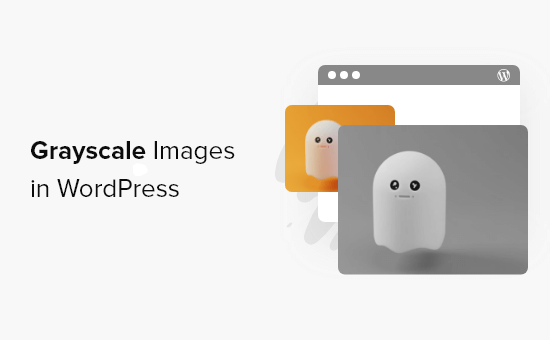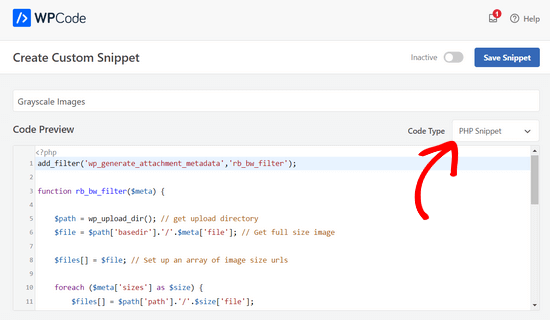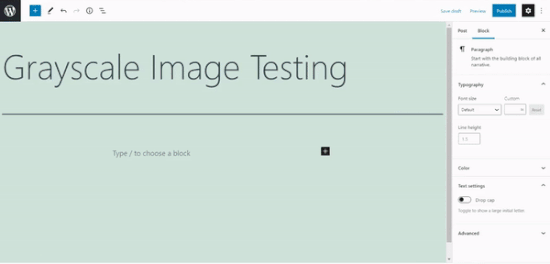Você está se perguntando se existe uma maneira de colocar imagens em escala de cinza automaticamente no WordPress quando você as carrega?
Normalmente, você precisa de uma ferramenta de edição de fotos para alterar suas imagens para tons de cinza. No entanto, isso pode ser demorado, pois você precisará editar cada imagem individualmente antes de carregá-la em seu site.
Neste artigo, mostraremos como fazer o upload de imagens em escala de cinza no WordPress para o seu site.

Quando você deve usar imagens em tons de cinza no WordPress?
As imagens em escala de cinza contêm apenas informações sobre a quantidade de luz na imagem. As cores da imagem mostram diferentes tons de cinza, variando entre preto e branco.
Em determinadas situações, o uso de imagens em tons de cinza pode ser benéfico para seu site WordPress. Por exemplo, você pode usá-las para melhorar a legibilidade dos objetos mostrados na imagem.
Por outro lado, as imagens em escala de cinza são comumente usadas para processamento de imagens devido ao seu pequeno tamanho. Isso permite que os desenvolvedores executem operações complexas em um tempo mais curto.
Dito isso, vamos ver como você pode transformar suas imagens em tons de cinza no WordPress ao carregá-las.
Imagens em cinza ao fazer upload no WordPress
Quando se trata de adicionar imagens no WordPress, você precisa editá-las antes de fazer o upload usando um software de edição de fotos como o Photoshop e converter imagens coloridas em escala de cinza.
Se você tiver centenas ou milhares de imagens para carregar, pode levar muito tempo para editar cada imagem manualmente.
No entanto, você pode transformá-las automaticamente em imagens em tons de cinza após o upload. Para começar, tudo o que você precisa fazer é adicionar o seguinte código ao arquivo functions.php do seu tema:
add_filter('wp_generate_attachment_metadata','rb_bw_filter');
function rb_bw_filter($meta) {
$path = wp_upload_dir(); // get upload directory
$file = $path['basedir'].'/'.$meta['file']; // Get full size image
$files[] = $file; // Set up an array of image size urls
foreach ($meta['sizes'] as $size) {
$files[] = $path['path'].'/'.$size['file'];
}
foreach ($files as $file) { // iterate through each image size
// Convert image to grayscale credit to http://ottopress.com/2011/customizing-wordpress-images/
list($orig_w, $orig_h, $orig_type) = @getimagesize($file);
$image = wp_load_image($file);
imagefilter($image, IMG_FILTER_GRAYSCALE);
switch ($orig_type) {
case IMAGETYPE_GIF:
imagegif( $image, $file );
break;
case IMAGETYPE_PNG:
imagepng( $image, $file );
break;
case IMAGETYPE_JPEG:
imagejpeg( $image, $file );
break;
}
}
return $meta;
}
Uma maneira simples de adicionar código aos arquivos de tema é usar o plug-in WPCode para WordPress.
É o melhor plug-in de snippets de código que ajuda a executar snippets de código sem a necessidade de editar manualmente o arquivo function.php do seu tema. Dessa forma, você não precisa se preocupar em danificar seu site.

Primeiro, você precisará fazer o download e instalar o plug-in gratuito WPCode em seu site. Se precisar de ajuda, siga nosso guia sobre como instalar um plug-in do WordPress.
Observação: a versão gratuita do WPCode oferece tudo o que você precisa para adicionar facilmente códigos personalizados no WordPress. Para obter recursos mais avançados, como uma biblioteca de snippets em nuvem privada, snippets programados, pixels de conversão e muito mais, você pode fazer upgrade para o WPCode Pro.
Após a ativação, você pode ir até Code Snippets ” + Add New no painel do WordPress.
Em seguida, navegue até a opção “Add Your Custom Code (New Snippet)” (Adicionar seu código personalizado (novo snippet)) e clique no botão “Use snippet” (Usar snippet).

Em seguida, digite um nome para o snippet e cole o código acima na área “Code Preview” (Visualização de código).
Você também precisa selecionar “PHP Snippet” como o tipo de código na lista suspensa à direita.

Depois de inserir o código, você pode rolar para baixo até a seção “Inserção”.
Aqui, você pode deixar a opção “Auto Insert” (Inserção automática) selecionada. Isso inserirá e executará automaticamente o código para você.

Por fim, volte à parte superior da tela e alterne a chave de “Inativo” para “Ativo” e clique no botão “Salvar snippet”.

Em seguida, você pode testar o código editando ou adicionando uma nova página. Quando estiver no editor do WordPress, clique no botão “+” e adicione um bloco de imagem.
Agora você pode carregar qualquer imagem em seu blog do WordPress e ela será automaticamente convertida em uma imagem em tons de cinza.

Esperamos que este artigo tenha ajudado você a aprender como fazer imagens em escala de cinza no WordPress. Você também pode conferir nosso guia sobre como escolher a melhor plataforma de blog e nossas escolhas de especialistas sobre o melhor software de web design.
Se você gostou deste artigo, inscreva-se em nosso canal do YouTube para receber tutoriais em vídeo sobre o WordPress. Você também pode nos encontrar no Twitter e no Facebook.





Syed Balkhi says
Hey WPBeginner readers,
Did you know you can win exciting prizes by commenting on WPBeginner?
Every month, our top blog commenters will win HUGE rewards, including premium WordPress plugin licenses and cash prizes.
You can get more details about the contest from here.
Start sharing your thoughts below to stand a chance to win!
Tomas Kapler says
Great tip, i would just like to mention, that for many usages it might be better to simply do this via CSS filter, e.g.
img.bw {
filter: grayscale(1);
}
you can even e.g. show b/w by default and color on hover, or you can do animation from greyscale to full color and back, e.g.
img.bw {
filter: grayscale(0);
}
img.bw.grey {
filter: grayscale(1);
transition-property: filter;
transition-duration: 1s;
}
i also do not think, that wp_generate_attachment_metadata filter is the proper one, that should be used because of its calling in meta creation not only image creation and making second image manipulation, but the proper solution would be much longer, so i understand why it is done this way
rok says
It works nice but when uploading, WP 4.3 throws error in media library.
i think have applied all fixes written in comments, but still error.
my code looks like this:
add_filter(‘wp_generate_attachment_metadata’,’themename_bw_filter’);
function themename_bw_filter($meta) {
$time = substr( $meta[‘file’], 0, 7); // <- get the correct time of the upload
$file = wp_upload_dir( $time ); // <- locates the correct upload directory
$file = trailingslashit($file[‘path’]).$meta['sizes']['slide-pic']['file'];
if( $file ) {
list($orig_w, $orig_h, $orig_type) = @getimagesize($file);
}
$image = wp_load_image($file);
imagefilter($image, IMG_FILTER_GRAYSCALE);
switch ($orig_type) {
case IMAGETYPE_GIF:
imagegif( $image, $file );
break;
case IMAGETYPE_PNG:
imagepng( $image, $file );
break;
case IMAGETYPE_JPEG:
imagejpeg( $image, $file );
break;
}
return $meta;
}
Kim says
Will this change all pictures in word press to grayscale or only newly updates ones?
Tomaž Zaman says
I know I’m a bit late to the discussion, but I just had the same problem with an error (that others report):
imagefilter() expects parameter 1 to be resource, string givenThis happens when you try to upload image through media modal while editing a post, older than the current month which apparently confuses WordPress which directory the original image is in and which directory it should save the grayscaled image in.
This is the solution:
<?php
add_filter('wp_generate_attachment_metadata','themename_bw_filter');
function themename_bw_filter($meta) {
$time = substr( $meta['file'], 0, 7); // <- get the correct time of the upload
$file = wp_upload_dir( $time ); // <- locates the correct upload directory
$file = trailingslashit($file['path']).$meta['sizes']['themename-bw-image']['file'];
list($orig_w, $orig_h, $orig_type) = @getimagesize($file);
$image = wp_load_image($file);
imagefilter($image, IMG_FILTER_GRAYSCALE);
switch ($orig_type) {
case IMAGETYPE_GIF:
imagegif( $image, $file );
break;
case IMAGETYPE_PNG:
imagepng( $image, $file );
break;
case IMAGETYPE_JPEG:
imagejpeg( $image, $file );
break;
}
return $meta;
}
endul says
how to change, result filter image to specific folder/directory
geertvdheide says
One addition: I’ve added a few lines to get around the issue of having two images with the same file name, caused by having two add_image_size calls with the same size. The additional code was found here:
http://bavotasan.com/2011/create-black-white-thumbnail-wordpress/
mklemme says
@geertvdheide
If you wanted to add multiple size support, try what I use:
if ( function_exists( ‘add_theme_support’ ) ){
add_theme_support( ‘post-thumbnails’ );
set_post_thumbnail_size( 50, 50, true );
add_image_size( ‘medium-thumb’, 660, ”, true );
add_image_size( ‘large-thumb’, 960, ”, true );
add_image_size( ‘small-thumb’, 100, ”, true );
}
(The height is not defined, only the width.)
you would have to add the different names to make the function apply to them all:
[‘medium-thumb’ , ‘large-thumb’ , ‘small-thumb’] in the filter code.
Calling the thumbnail in your theme is the same listed in the article:
Mike Logan says
Excellent idea, almost 10 years later this is still handy.
geertvdheide says
Thanks for sharing this code! Except I’m running into a weird issue when trying to implement it. It’s related to the uploaded image’s size (pixel size, meaning its dimensions). Copied the code literally to my theme’s functions.php, and it works a charm with images larger than the size specified in the add_image_size call. But when using an image smaller than or equal to the size specified, the uploader in WordPress gives me errors and doesn’t process the image size (either from the media section of the admin environment, or from a specific post or page). The error:
Warning: imagefilter() expects parameter 1 to be resource, string given.
Ssome other stuff in the error as well, but this seems to be the main cause. The image data given to the imagefilter function must not be valid or doesn’t exist?
Any idea what’s causing this? The only real difference between my situation and a clean install is that I’ve also added a few other add_image_size calls for other purposes in my site. I’m also adding the same size twice (one black/white, one regular), but that doesn’t seem to be a problem with the larger images.
Ed Nailor says
@GEERTVDHEIDE
and for others that need this:
When the script is converting the image to greyscale and the file uploaded does not fit the file size, this causes the script to break. To prevent this, simply add a quick if() conditional to make sure you have the $file.
$file = trailingslashit($file[‘path’]).$meta[‘sizes’][‘themename-bw-image’][‘file’];
if( $file ) {
list($orig_w, $orig_h, $orig_type) = @getimagesize($file);
——– remainder of code until ——–
return $meta;
}
This will check to make sure the file size you have requested exists before it tries to convert it.
Hope that helps!
frankiegershwin says
@Otto42 Thanks for offering. I will.
Otto42 says
@frankiegershwin bummer! Feel free to email me directly for code help. otto@wordpress.org
frankiegershwin says
@Otto42 thank you! I had a bit of a hard time, actually and had to undoe it will pick it up tomorrow. It’s a good way to mix it up onsite
will pick it up tomorrow. It’s a good way to mix it up onsite
Otto42 says
@frankiegershwin Lemme know if you need help. I added a way to do sepia tones too in my comments on the original post: http://t.co/avDNNEX
rodhk says
@rodriguezhernan vaya idiotez de truco…. madremua tocar el codigo para eso
wpbeginner says
@Otto Thanks for the comment Otto. Updated the post as well
Otto says
Note that people should change “themename” to be the name of their theme instead.